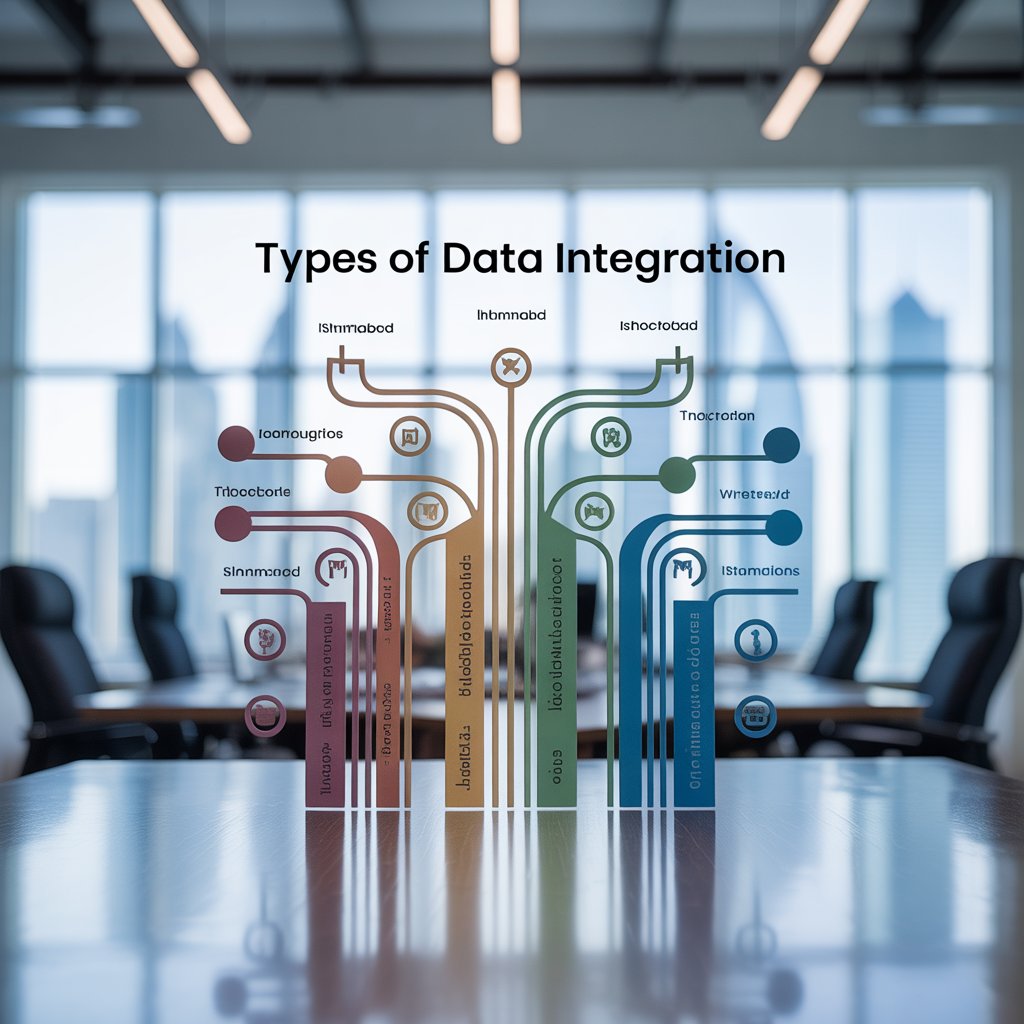Digital transformation, the seamless flow of information, is the backbone of innovation and efficiency. Yet, unifying data from disparate sources can be a daunting challenge. That’s where the types of data integration come into play empowering organizations to bridge silos, unlock insights, and create synergy across platforms.
The Key Purpose of Integral Type Data in Integration
At the heart of integration lies a crucial component: understanding the key purpose of integral type data. Integral data types ensure consistency, accuracy, and a foundation for meaningful analytics, making them essential in any integration scenario.

Digital Web Understanding Types of Data Integration
Types of Data Integration Approaches
No two organizations share the same journey. That’s why the types of data integration approaches span a diverse spectrum each tailored to unique operational needs. The most recognized forms include
- Manual Integration:
Direct, hands-on movement of data between systems a method suited for small volumes or one-time migrations. - Middleware Integration:
Utilizing specialized software that acts as a bridge, allowing applications to “talk” to each other without direct code changes. - Application-Based Integration:
Embedding connectors within apps for real-time data exchange, ideal for dynamic, fast-paced environments. - Uniform Data Access Integration:
Creating a virtual view of multiple sources, letting users query data as if it exists in a single repository. - Common Storage Integration:
Consolidating scattered information into a central database, simplifying access, and analytics.
Safeguarding Value: Types of Data Breach Integrity and Its Role
While integration promises unity, it also raises questions about security. Different types of data breach integrity must be understood to prevent vulnerabilities. Common threats include unauthorized modifications, accidental deletions, and malicious intrusions all of which can compromise trust and utility.
Fundamentals Matter: What are the Types of Data Integrity?
True integration doesn’t stop at merging information; it’s about preserving meaning and trustworthiness. The types of data integrity focus on:
- Entity Integrity:
Ensuring each data point remains unique and identifiable. - Referential Integrity:
Maintaining logical relationships between datasets. - Domain Integrity:
Guaranteeing values remain within acceptable parameters. - User-Defined Integrity:
Custom rules set by organizations for specialized requirements.
Mapping the Landscape: What Are the Types of Data Integration?
When seeking to unify information, it’s vital to know what types of data integration are available:
- Consolidation:
Gathering data from multiple origins into a single warehouse for unified analytics. - Propagation:
Distributing data changes across systems, either in real-time or scheduled batches. - Federation:
Offering a unified query experience across different data stores without physically moving data. - Virtualization:
Creating an abstraction layer that enables access to data regardless of its actual location. - Synchronization:
Ensuring updates in one source automatically reflect in others.
Five Unique Bullet Points: Why Data Integration Matters
- Accelerates Decision-Making: Rapid access to unified insights empowers timely, strategic moves.
- Enhances Data Quality: Integrated systems reduce redundancies and improve accuracy.
- Streamlines Operations: Automation of data flows eliminates manual errors and bottlenecks.
- Boosts Innovation: Connected datasets reveal new patterns and opportunities.
- Strengthens Compliance: Consistent records simplify audit trails and regulatory adherence.
Innovative Trends: Types of Data Integration Methods for Modern Enterprises
As technology evolves, so do types of data integration methods. Today’s leading organizations leverage:
- Cloud Integration:
Unifying cloud and on-premises data for hybrid agility. - API-Based Integration:
Connecting applications and services through standardized interfaces. - ETL (Extract, Transform, Load):
Moving and reshaping data for analytics and reporting. - Data Lakes:
Storing structured and unstructured data in scalable, flexible repositories.
Digital Web: Understanding Types of Data Integration
In today’s era of digital transformation, the seamless flow of information is the backbone of innovation and efficiency. Yet, unifying data from disparate sources can be a daunting challenge. That’s where the types of data integration come into play empowering organizations to bridge silos, unlock insights, and create synergy across platforms.
The Key Purpose of Integral Type Data in Integration
At the heart of integration lies a crucial component: understanding the key purpose of integral type data. Integral data types ensure consistency, accuracy, and a foundation for meaningful analytics, making them essential in any integration scenario.
A Spectrum of Solutions: Types of Data Integration Approaches
No two organizations share the same journey. That’s why the types of data integration approaches span a diverse spectrum each tailored to unique operational needs. The most recognized forms include
- Manual Integration:
Direct, hands-on movement of data between systems a method suited for small volumes or one-time migrations. - Middleware Integration:
Utilizing specialized software that acts as a bridge, allowing applications to “talk” to each other without direct code changes. - Application-Based Integration:
Embedding connectors within apps for real-time data exchange, ideal for dynamic, fast-paced environments. - Integration of Uniform Data Access:
Creating a virtual view of multiple sources, letting users query data as if it exists in a single repository. - Common Storage Integration:
Consolidating scattered information into a central database, simplifying access, and analytics.
Safeguarding Value: Types of Data Breach Integrity and Its Role
While integration promises unity, it also raises questions about security. Different types of data breach integrity must be understood to prevent vulnerabilities. Common threats include unauthorized modifications, accidental deletions, and malicious intrusions all of which can compromise trust and utility.
Fundamentals Matter: What are the Types of Data Integrity?
True integration doesn’t stop at merging information; it’s about preserving meaning and trustworthiness. The types of data integrity focus on:
- Entity Integrity:
Ensuring each data point remains unique and identifiable. - Referential Integrity:
Maintaining logical relationships between datasets. - Domain Integrity:
Guaranteeing values remain within acceptable parameters. - User-Defined Integrity:
Custom rules set by organizations for specialized requirements.
Mapping the Landscape: What Are the Types of Data Integration?
When seeking to unify information, it’s vital to know what types of data integration are available:
- Consolidation:
Gathering data from multiple origins into a single warehouse for unified analytics. - Propagation:
Distributing data changes across systems, either in real-time or scheduled batches. - Federation:
Offering a unified query experience across different data stores without physically moving data. - Virtualization:
Creating an abstraction layer that enables access to data regardless of its actual location. - Synchronization:
Ensuring updates in one source automatically reflect in others.
Five Unique Bullet Points: Why Data Integration Matters
- Accelerates Decision-Making: Rapid access to unified insights empowers timely, strategic moves.
- Enhances Data Quality: Integrated systems reduce redundancies and improve accuracy.
- Streamlines Operations: Automation of data flows eliminates manual errors and bottlenecks.
- Boosts Innovation: Connected datasets reveal new patterns and opportunities.
- Strengthens Compliance: Consistent records simplify audit trails and regulatory adherence.
Innovative Trends: Types of Data Integration Methods for Modern Enterprises
As technology evolves, so do types of data integration methods. Today’s leading organizations leverage:
- Cloud Integration:
Unifying cloud and on-premises data for hybrid agility. - API-Based Integration:
Connecting applications and services through standardized interfaces. - ETL (Extract, Transform, Load):
Moving and reshaping data for analytics and reporting. - Data Lakes:
Storing structured and unstructured data in scalable, flexible repositories.
To guarantee seamless digital transformation, follow these types of data integration best practices: assess business needs, select the right integration method, monitor data flows, and prioritize ongoing security. Remember effective integration is a journey, not a one-time event.
FAQs
What is the key purpose of integral-type data in integration?
The key purpose of integral-type data is to maintain accuracy and consistency during the merging of information from various sources.
How do types of data integration approaches differ?
Types of data integration approaches range from manual processes to automated middleware, each offering distinct advantages for different needs.
Why is understanding types of data breach integrity important?
Recognizing various types of data breach integrity helps organizations address vulnerabilities and strengthen security measures.
What are the types of data integrity?
Types of data integrity include entity, referential, domain, and user-defined rules, all ensuring reliable and meaningful datasets.
Can you explain what an integral data type is?
What is integral data? “Type” refers to categories of numeric values crucial for organizing and processing integrated datasets.
What are the main types of data integration methods?
Types of data integration methods include consolidation, federation, propagation, virtualization, and synchronization for different business needs.
Why are data integration types crucial for digital transformation?
Selecting the right data integration types accelerates digital strategy, enhances efficiency, and supports seamless information flow.














